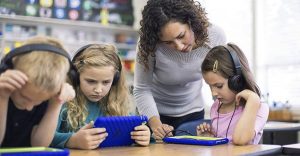With the rapid advancement of technology, education is evolving to become more accessible, personalized, and interactive. From online learning platforms to cutting-edge tools like virtual reality (VR) and artificial intelligence (AI), “Tech Digital Learning” has become more than just a trend; it’s a significant evolution shaping the future of education in the United States. This
With the rapid advancement of technology, education is evolving to become more accessible, personalized, and interactive. From online learning platforms to cutting-edge tools like virtual reality (VR) and artificial intelligence (AI), “Tech Digital Learning” has become more than just a trend; it’s a significant evolution shaping the future of education in the United States. This article explores the benefits of technology in digital learning, showcases real-world case studies, and considers what lies ahead.
Benefits of Tech in Digital Learning

Image by Yandex.com
1. Enhanced Accessibility and Flexibility
Technology has greatly increased educational accessibility by breaking down physical and geographic barriers, allowing learning to take place anytime and anywhere. This flexibility enables students with different backgrounds, abilities, and locations to participate in quality education.
Example: Stanford Online High School offers high school students across the U.S. access to rigorous, college-preparatory courses, regardless of where they live. The flexibility of online courses helps bridge the gap for students in remote areas, making quality education accessible to a wider audience.
2. Personalized Learning Experiences
With the help of technology, learning experiences can now be customized to fit individual needs. Adaptive learning platforms can assess a student’s progress and adjust the difficulty or pacing of lessons accordingly, which aids in deeper understanding and supports diverse learning styles.
3. Engagement and Interactivity
Traditional classroom settings can sometimes be passive, but technology offers interactive tools that engage students more actively. Virtual reality, simulations, and gamified apps make learning immersive, helping students retain knowledge more effectively.
Example: CodeCombat is an educational platform that teaches coding through a game-based environment, targeting middle and high school students in the U.S. By completing coding challenges in a fantasy-style game, students learn programming concepts in an engaging and interactive manner.
4. Collaboration and Communication
In today’s digital world, collaboration is essential, and technology facilitates it through real-time communication tools. These platforms enable students and teachers to work together on projects, share ideas, and discuss topics seamlessly, regardless of physical distance.
Example: Google Classroom, widely used in schools across the U.S., allows for collaborative document editing, assignment management, and streamlined communication between teachers and students. It’s particularly effective for blended learning environments, where students split their time between online and in-person education.
5. Real-Time Feedback and Assessment
Immediate feedback is critical to effective learning. Technology allows educators to assess students’ understanding in real time, enabling timely support and adjustments in lesson plans based on student performance.
Arizona State University uses a learning management system (LMS) that incorporates real-time feedback for students. By analyzing student engagement and performance, the system helps educators identify areas where students might need additional support.
6. Cost-Effectiveness
The cost of quality education can be a barrier for many students. Online resources, virtual classrooms, and digital textbooks help reduce overall educational expenses, benefiting both institutions and students.
Example: OpenStax, a nonprofit organization based at Rice University, provides free, peer-reviewed, openly licensed textbooks for high school and college courses. By making these resources freely available, OpenStax reduces the cost of course materials and promotes accessible education.
Real-Life Applications of Tech in Digital Learning
Google Classroom During the COVID-19 Pandemic
Google Classroom transformed U.S. education during the pandemic by offering a straightforward, accessible platform for virtual learning. Used by schools nationwide, it allowed teachers to create assignments, provide feedback, and engage students remotely. This platform was instrumental in enabling schools to transition smoothly to a blended or fully online learning model, ensuring continuity in education.
Virtual Reality in Medical Training at Stanford University

Image by Yandex.com
Stanford University has incorporated VR into its medical training programs, allowing students to practice surgeries and other complex procedures in a simulated environment. This approach provides hands-on experience without the risks associated with real-life practice, offering a safe way to master complex medical skills.
AI-Powered Learning Analytics at Georgia State University
Georgia State University (GSU) has adopted AI-driven learning analytics to track student performance and predict potential dropouts. By monitoring engagement and performance, GSU’s analytics platform identifies students who may need additional support, helping improve retention rates and ensuring academic success.
Examples of Tech Tools Enhancing Digital Learning
Virtual Reality (VR) and Augmented Reality (AR)
Example: VR is being used in U.S. high schools to offer virtual field trips. For instance, students can explore historical landmarks in a VR environment, allowing them to engage with history in an immersive way that traditional textbooks cannot provide.
Artificial Intelligence (AI)
Example: Carnegie Learning, based in Pittsburgh, uses AI to create customized math tutoring solutions that provide real-time, personalized support. This AI-driven tutoring adjusts to the student’s pace, offering targeted assistance when needed.
Learning Management Systems (LMS)
Example: Blackboard, widely used in U.S. universities, integrates course materials, assessments, and grading into one platform, allowing teachers to organize content effectively and students to access resources easily.
E-Books and Online Libraries
Example: Project MUSE provides access to a wide range of academic journals and books, supporting students across the U.S. in finding resources for research and study.
Challenges in Adopting Tech in Digital Learning
1. Digital Divide
While technology offers numerous benefits, not all students have equal access to the necessary tools. Limited access to reliable internet or devices is a significant barrier to digital learning, particularly in rural or low-income areas.
2. Teacher Training and Adoption
To maximize the benefits of tech-driven learning, educators need comprehensive training in using new tools. Implementing these technologies can require significant adaptation, especially for those unfamiliar with digital teaching methods.
3. Privacy and Data Security
Data security and privacy are concerns, particularly with the use of AI and analytics in education. Schools and platforms must ensure student data is protected, balancing innovation with privacy safeguards.
Future of Technology in Digital Learning
AI and Machine Learning
AI will continue to shape personalized learning by predicting student needs and adjusting course material accordingly. Machine learning models can help create a more responsive learning environment that meets individual students’ needs.
Immersive Technologies
The expansion of VR and AR will provide students with opportunities to experience concepts in a fully immersive way. Science, history, and medical education are expected to see transformative changes, offering simulated real-life experiences for students.
Blockchain for Credential Verification
Blockchain technology could revolutionize the verification of academic records, enabling secure, verifiable digital credentials. This advancement will simplify the process for students to prove their qualifications to potential employers or academic institutions.
Conclusion
Technology has brought an unparalleled level of innovation to digital learning, making education more accessible, personalized, and engaging. From real-world case studies in top U.S. academies to the many benefits tech offers, it’s clear that digital learning powered by technology is reshaping the educational landscape. Moving forward, it’s essential for educators, institutions, and policymakers to continue embracing and investing in these advancements, ensuring that technology-enhanced learning remains accessible and inclusive for all.






















